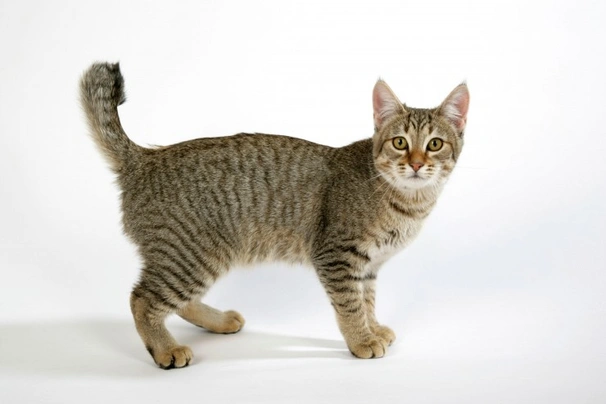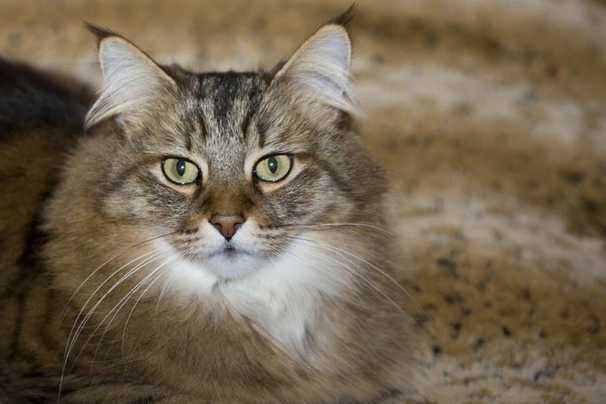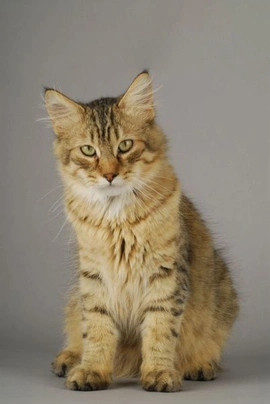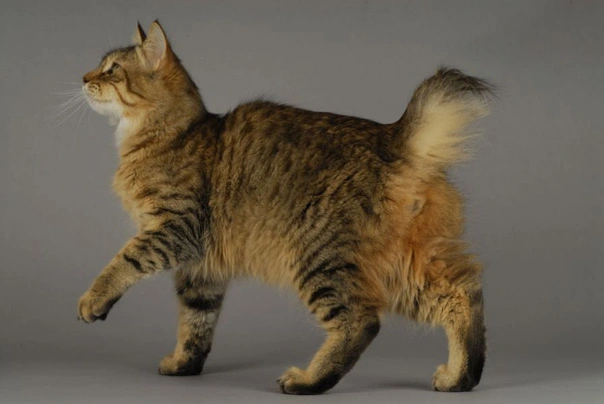Pixie Bob
Introduction of the Pixie Bob
The Pixie Bob has the look of a wild bobcat but they boast having kind affectionate natures and can even be taught to walk on a lead much like their canine counterparts. They are large cats with males being that much heavier and larger than females. Since they first appeared on the scene Pixie Bobs have found their way into the hearts and homes of many people in their native America and elsewhere in the world thanks to their unique looks and their kind loving natures. Their numbers are slowly rising in the UK but anyone wishing to share a home with a Pixie Bob would need to go on a waiting list because not many well-bred kittens are available every year.
History of the Pixie Bob
The Pixie Bob is what is known as a polydactyl breed because they have more than the usual number of toes on one or more of their feet. The breed came about when a lady called Carol Ann Brewer bought a spotted male kitten with a short tail and patterned coat in 1985. The male cat was unusually tall so she crossed him with a neighbour's domestic spotted cat. They produced a litter of kittens one of which was a female that boasted having a muted spotted reddish-fawn coloured coat. She named the kitten Pixie. In 1987 Carol Ann Brewer realised that her bobtailed cats had a very distinct look about them and started searching for more similar type cats which she then used in a breeding programme to create a wild looking polydactyl cat with a short or bobtail.
In 1989 she drew up a standard to represent the traits she hoped to breed into her short tailed cats and decided to call them Pixie Bobs then in 1993 she contacted TICA with her end goal being to gain recognition for her new breed. She eventually gained Exhibition Status for the breed in 1994 and the breed was awarded full Championship status four years later in 1998. Today although still quite rare in the UK the Pixie Bob is gaining a fan base with more breeders becoming interested in these charming wild looking cats and as such their numbers and popularity are rising.
Appearance of the Pixie Bob
Pixie Bobs bear a resemblance to North American Bobcats and can either have a long coat or a short double coat which has a woolly feel to it. Other distinct physical traits are the Lynx type tufts on their ears and a cat's facial hair which grows downwards giving the Pixie Bob their muttonchop sideburns. Males tend to be quite a bit heavier and larger than their female counterparts but both are large and extremely attractive looking cats.
They have medium to large sized heads which are shaped like an inverted pear. Their ears are a medium height with rounded tops with tufts being more prominent in longer haired cats than they are in short coated Pixies. Ears are set wide apart being wider at the base and set with a slight outward tilt which adds to the Pixie Bob's wild look. Their eyes are medium in size being heavily hooded and forming a gentle triangle. A Pixie Bob's eyes are deep set and set nicely apart being gold brown or gooseberry green in colour. They have well-developed chins which are covered in fuzzy harsh to the touch hair and which align nicely with a cat's nose. Muzzles are broad and full with cats having rounded whisker pads with a well-defined break. Their noses are large a little convex and wide with a slight bump. Nose leathers are a brick colour.
The Pixie Bob boasts having a large and rangy body that's medium to large and their shoulder blades are prominent. Their backs have a slight upward slope to a cat's hips which boast being a moderate width and prominent. Their hips are higher than a cat's shoulders but then they slope down to their tails. Chests are broad and flanks deep with cats having a primordial belly pouch. Their legs are long with the back ones being slightly longer than their front legs. Feet are large wide and long being almost round and their toes are large pointing forwards. Tails are at least two inches long and well covered in hair.
Shorthaired Pixie Bobs (PB) boast having a short coat that stands up from the body with the hair on their bellies being that much longer. Their coats are soft and woolly being resilient to the touch. Longhaired cats have hair that's at least two inches long with the hair being longer on their bellies. Their hair is soft to the touch and close lying being semi-dense. Pixie Bobs can be all shades of brown with their colours and patterns being as follows:
- Spotted Tabby - cats have a mouse coloured coat with reversed ticking. Their coat is lighter from their throats to their bellies. Paw pads and hocks are dark brown or black and the tip of their tails is dark brown or black. A white or cream band circles their eyes with cats having mascara markings from the outer corner of eyes down to their cheeks
- Patterns - cats have small to medium sized randomly placed spots which are muted by ticking. Bellies are nicely spotted.
Temperament of the Pixie Bob
Like other breeds the Pixie Bob likes a routine and doesn't particularly like it when this changes for any reason. They like to be fed at the same time of the day and don't appreciate it when furniture gets moved around the home which can often stress cats out. With this said they are active energetic cats that boast being quite dog-like in many ways. They form strong bonds with their owners and like to be with them as much as they can following them from room to room to check out what they are doing. However Pixie Bobs are not known to be overly demanding and are just as content spending time with another cat or dog they have grown up with.
They are inquisitive as well as quite talkative although they have quiet voices. Pixie Bobs chirp and chitter rather than meow when they want to communicate their feelings which adds to their endearing personalities especially as they are such large cats. They adore being part of a family and playing lots of interactive games. However when tired they are just as quick to relax and settle down for a nap in a favourite warm spot.
Intelligence / Trainability of the Pixie Bob
Pixie Bobs are highly intelligent and are often said to be very dog-like in many of their behaviours. They are quick to learn new things and can be taught to wear a harness and they like being taken out for walks. They enjoy playing interactive games like "fetch the toy" and being so smart they are quick at figuring things out which includes problem solving toys and games especially if they have food rewards in them. They are also quite adept at opening doors and cupboards so they can check what's inside and help themselves to a few treats at the same time.
Children and other
Pixie Bobs with their outgoing affectionate personalities are a good choice for families with children and this includes toddlers. They are quick on their feet and therefore know when to get out of the reach of smaller children when they get too boisterous or loud. However care should be taken when very young children are around cats and any interaction should always be well supervised by an adult to make sure things stay nice and calm. With this said children need to be taught how to behave around cats and when it's time to leave them alone.
They also get on well with dogs and other cats especially if they have grown up together in the same household. However care should always be taken when introducing a Pixie Bob to a dog they don't already know just in case the dog does not get on with their feline counterparts. They are social by nature and have been known to get on with pet birds and small animals. However it's always wiser to keep a close eye on any cat when they are around smaller pets particularly when they first meet each other just to be on the safe side.
Health of the Pixie Bob
The average life expectancy of a Pixie Bob is between 12 and 14 years when properly cared for and fed an appropriate good quality diet to suit their ages which is particularly important when they are very young and when they reach their golden years.
The Pixie Bob is known to be one of the healthier breeds and as such they are not known to suffer from the hereditary conditions that affect many other breeds. However they have been known to be sensitive to certain vaccinations which is something worth knowing about if you are planning to share your home with one of these large wild looking short tailed cats.
Caring for the Pixie Bob
As with other breeds Pixie Bobs need to be groomed on a regular basis to make sure their coats and skin are kept in top condition. On top of this cats need to be fed good quality food that meets all their nutritional needs throughout their lives which is especially true of kittens and older cats.
Grooming of the Pixie Bob
Pixie Bobs can have a short or long coat. Cats with shorter coats are easier maintenance on the grooming front than their longer haired counterparts. They only need a weekly brush and wipe over with a chamois leather to keep their coats in good condition with a nice sheen on it. Longer haired Pixie Bobs need more frequent brushing to prevent any knots and tangles from forming in their coats. Like other breeds they tend to shed the most in the Spring and then again in the Autumn when more frequent brushing is usually necessary to keep on top of things.
It's also important to check a cat's ears on a regular basis and to clean them when necessary. If too much wax builds up in their ears it can lead to a painful infection which can be hard to clear up. In short prevention is often easier than cure with ear infections. Cats often suffer from ear mites which can be a real problem which is another reason why it's so important to check their ears every week or so.
Exercise of the Pixie Bob
The Pixie Bob is an easy-going cat but one that likes to play interactive games. They are particularly good at problem solving which includes how to open cupboard and other doors so they can check out what's on the other side. The love exploring the great outdoors but cats should only be allowed to roam around outside if it is safe for them to do so. The good news is that Pixie Bobs adapt well to being kept as indoor cats providing they are given lots of attention and things to keep them occupied.
Cats kept as indoor pets need to be given lots of things to do and places to hide when they want to bearing in mind that Pixie Bobs like to climb up high so they can look down on things from a favourite vantage point. They also need to have lots of places they can snuggle up for a snooze when the mood takes them because if there’s one thing Pixies enjoy it’s taking a cat nap or two throughout the day.
Feeding of the Pixie Bob
If you get a Pixie Bob kitten from a breeder they would give you a feeding schedule and it's important to stick to the same routine feeding the same kitten food to avoid any tummy upsets. You can change a kitten's diet but this needs to be done very gradually always making sure they don't develop any digestive upsets and if they do it's best to put them back on their original diet and to discuss things with the vet before attempting to change it again.
Older cats are not known to be fussy eaters but this does not mean they can be given a lower quality diet. It's best to feed a mature cat several times a day making sure it's good quality food that meets all their nutritional requirements which is especially important as cats get older. It's also essential to keep an eye on a cat's weight because if they start to put on too much it can have a serious impact on their overall health and wellbeing. Like all other breeds Pixie Bobs need access to fresh clean water at all times.
Pixie Bob price
If you are looking to buy a Pixie Bob you would need to pay anything from £175 to over a £1000 for a well-bred kitten. The cost of insuring a male 3-year-old Pixie Bob in northern England would be £11.69 a month for basic cover but for a lifetime policy this would set you back £24.70 a month (quote as of February 2018). When insurance companies calculate a pet's premium they factor in several things which includes where you live in the UK a cat's age and whether they have been neutered or spayed among other things.
When it comes to food costs you need to buy the best quality food whether wet or dry making sure it suits the different stages of a cat’s life. This would set you back between £15 - £20 a month. On top of this you need to factor in veterinary costs if you want to share your home with a Pixie Bob and this includes their initial vaccinations their annual boosters the cost of neutering or spaying a cat when the time is right and their yearly health checks all of which quickly adds up to over £600 a year.
As a rough guide the average cost to keep and care for a Pixie Bob would be between £40 to £60 a month depending on the level of insurance cover you opt to buy for your cat but this does not include the initial cost of buying a well-bred kitten.

Pixie Bob kittens - LAST 2 REMAINING
£300
3 pixie bobs mixed
£150



